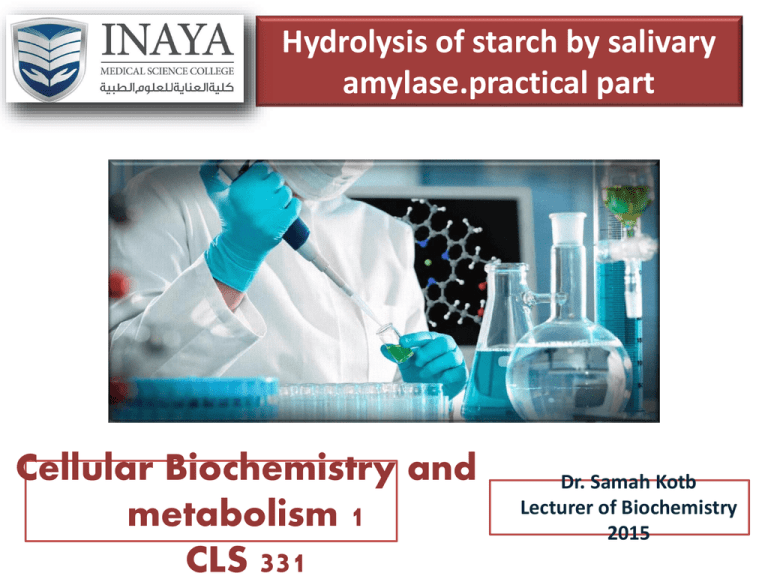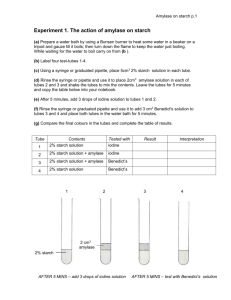Starch Hydrolysis by Salivary Amylase Lab Manual
advertisement

Hydrolysis of starch by salivary amylase.practical part Cellular Biochemistry and metabolism 1 CLS 331 Dr. Samah Kotb Lecturer of Biochemistry 2015 HYDROLYSIS OF STARCH BY SALIVARY AMYLASE HYDROLYSIS OF STARCH BY SALIVARY AMYLASE OBJECTIVES AND BACKGROUND • Amylase, an enzyme present in saliva, catalyzes the hydrolysis of the glycosidic linkages in starch. • The chemical reactions that go on in living organisms, and which are essential for growth, reproduction, movement, and all other vital functions, are individually and collectively referred to as metabolism. • Enzymes are proteins that act as catalysts for metabolic reactions. They increase the rate of the reaction, but do not influence the kind or amount of products formed. • In general, each metabolic reaction has to be catalyzed in the living organism by its own special enzyme. • The existence of enzymes in biological materials can be demonstrated by the effects they bring about. In this experiment, digestive enzymes capable of breaking down such polysaccharides as starch will be studied. Amylases • • Hydrolysis of starch is the process of digestion. Enzymes called amylases catalyze only the hydrolysis of glycosidic linkages in the amylose and amylopectin components of starch. • The hydrolysis does not proceed directly from polysaccharides to monomer units; rather, partial hydrolysis products of intermediate size are obtained. These products are maltose and dextrin. • Amylase enzymes are present in saliva, so the digestion of carbohydrates begins in the mouth. Digestion continues briefly in the stomach until the pH drops too low, and then is completed in the intestines by the attack of another amylase . Study of Enzyme Activity • To follow the action of an enzyme, it is necessary to test for the appearance of a product or the disappearance of a reactant over a measured period of time. • In the reactions of amylase with starch, you will test for the disappearance of starch by reacting samples of the reaction mixtures with iodine. • Initially, an unhydrolyzed starch solution reacts with iodine to give a blue-black color. The amylase catalyzes the hydrolysis of the alpha-1,4 glycosidic linkages, forming maltose and dextrin. • After the starch is hydrolyzed, the blue-black color produced with iodine is no longer observed, and only the red or gold color of the iodine solution is seen. • The faster the amylase hydrolyzes the starch, the sooner the failure of the blue-black color to appear is observed. • If the blue-black color continues to appear each time it is tested, it can be concluded that the enzyme is no longer active and that no hydrolysis of starch has occurred. • The time required for the hydrolysis of starch will be correlated to the relative enzyme activity. • When enzyme activity is high, the time for the starch to hydrolyze will be very short. • In some cases, the enzyme will be completely inactivated and the blue-black color of the starch and iodine will persist throughout the entire experiment. • PROCEDURE • 1. Collect approximately 5 ml of saliva in a medium test tube. • 2. Place 2 droppers full of 1 % starch solution in each of 5 medium test tubes. Number the test tubes 1-5. • 3. Place the tubes in a 37 °C water bath. After 5 minutes, add the equivalent amounts of saliva to the test tubes as quickly as possible, mixing each solution thoroughly, and then returning the tubes to the water bath. • 4. Prepare a spot plate for testing for the presence of starch in the samples by placing one drop of iodine reagent in each of five depressions on the spot plate. • 5. Two minutes after the addition of saliva, transfer one drop from each test tube (using a different pipette for each tube) to a separate drop of iodine in the spot plate. • Note the color produced for each. Remember that the complex formed by starch and iodine is an indigo blue. If the color of the iodine solution remains red or gold after adding the starch solution, the starch has been completely hydrolyzed. • 6. Clean the spot plate and then prepare it for the next testing by placing one drop of iodine reagent in each of five depressions. • 7. Repeat the testing at 5 minutes after the addition of saliva, and at 5 minute intervals thereafter. Continue testing for 20 minutes, or until the blueblack color no longer appears for each sample. • 8. Record the time required for the hydrolysis of starch in each sample.





